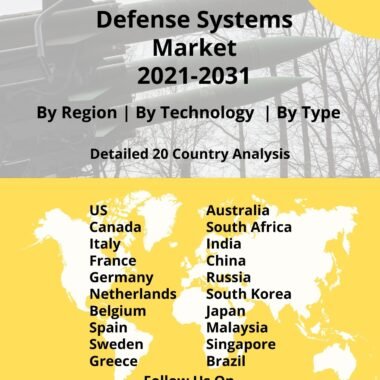Description
Global Electronic Warfare Market
Frequently Asked Questions of Electronic Warfare Market
The term “electronic warfare” refers to military operations that target the adversary or influence the electromagnetic spectrum using electromagnetic and directed energy. Due to recent advancements in electromagnetic technology, EW capabilities are increasing. They have a dynamic impact on the electromagnetic spectrum through delivery and integration with other types of emerging weapons and capabilities. High-powered microwaves, lasers, infrared, and electro-optical and wireless networks and equipment are a few examples of directed-energy weapons.
An operational environment is a group of elements that affect how capabilities are used and guide commanding decisions. The operating environment includes the domains of air, land, sea, and space. It also includes information that affects the operating environment as well as enemy, adversary, friendly, and neutral systems that are relevant to a combined operation. During military operations, both ally and adversary leaders rely on the flow of information to make educated decisions. This information flow depends on the electronic devices and systems that transmit, navigate, sense, store, and process data.
Major factors driving Electronic Warfare Market Growth
An increase in the defense budget is poised to be one of the key factors that are expected to drive the growth associated with electronic warfare systems. The growth in tactical ability associated with military firearms is expected to be one of the key factors that are anticipated to drive the demand for electronic warfare systems. Another factor that is expected to drive the growth associated with this market is the increase in geo-political conflicts. The growth in border tensions and the strained relations between nations is poised to serve as a growth factor. For instance, the border tensions between India- and China have led to the two nations investing drastically in defense and security systems.
Trends influencing the EW Market Size
Commanders aim to dominate the electromagnetic spectrum in any warfare. They accomplish this by detecting, targeting, exploiting, interrupting, degrading, misleading, denying, or destroying enemy electronic systems that support military operations, or by preventing allied forces from using the spectrum. Because sophisticated electronic equipment is becoming more portable and affordable, the electromagnetic environment in which forces work will become increasingly more complex. Commander’s plan, develop, execute, and review EW operations against a broad variety of targets within the electromagnetic spectrum to ensure unrestricted access to and usage of the spectrum.
EW Market Forecast & Dynamics
Electronic attack, electronic protection, and electronic warfare assistance are the three subcategories of the electronic warfare sector. An electronic attack is a sort of conflict in which troops, infrastructure, or equipment are targeted with electromagnetic energy, directed energy, or anti-radiation weapons to reduce, neutralize, or eradicate the enemy’s combat capability. The three main types of electromagnetic jamming are spot, barrage, and sweep. Electronic attack activities also employ a variety of electromagnetic deception strategies, such as the creation of a false target or a duplicate target.
The use of this technology is poised to increase owing to the growing lethality of weapons being employed by various systems. Electronic warfare is anticipated to revolutionize battlefield management technologies through soft-kill and hard-kill countermeasures that prevent harm from being caused against both military equipment as well as personnel. The use of this technology is hereby poised to improve soldier morale since it provides added protection within a battle scenario.
Electronic Warfare Market Analysis for Recent Developments
Growth in the number of indigenous programs is expected to be one of the key factors which are poised to drive the growth associated with the electronic warfare systems market. The increased domestic sourcing is expected to drive the direct, indirect as well as induced sources of employment across the overall Indian defense sector. India is known to be making strides within this segment with the Make in India initiative. As of 2022, it was noted that two contracts worth a combined Rs 3,102 crore were signed by the Indian Defence Ministry with Bharat Electronics Limited’s Bengaluru and Hyderabad divisions (BEL). A contract for the delivery of an advanced electronic warfare (EW) suite for Indian Air Force fighter aircraft was reached between the Defense Ministry and BEL-Bengaluru. The contract is expected to cost a total of Rs 1,993 crore.
The global landscape of electronic warfare (EW) has seen significant advancements, reflecting the critical role of electronic countermeasures in modern military operations. Electronic warfare involves the use of electromagnetic spectrum control to protect friendly forces, disrupt enemy communication, and ensure mission success. Advancements in electronic warfare include the development of sophisticated jamming systems, signal intelligence capabilities, and cyber-electromagnetic activities. These technologies enhance the ability to counter and exploit adversarial electronic systems across land, sea, air, and space domains.
The integration of artificial intelligence and machine learning into electronic warfare systems improves real-time decision-making, enabling adaptive and responsive countermeasures against evolving threats. Global defense forces focus on enhancing interoperability and collaboration in electronic warfare capabilities to counter shared threats. Standardization efforts and joint exercises ensure that allied nations can seamlessly operate together in electronic warfare scenarios. The ongoing evolution of electronic warfare in 2023 underscores a commitment to technological innovation, information dominance, and the ability to control the electromagnetic spectrum in the face of dynamic and sophisticated adversaries.







